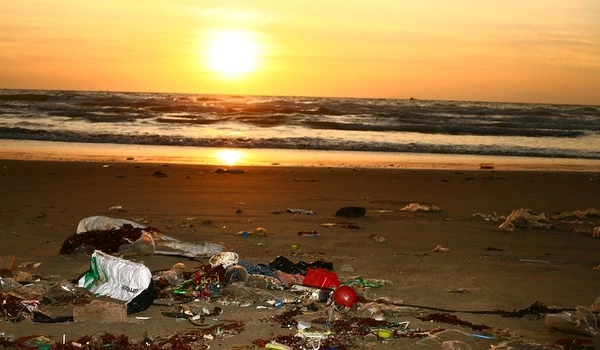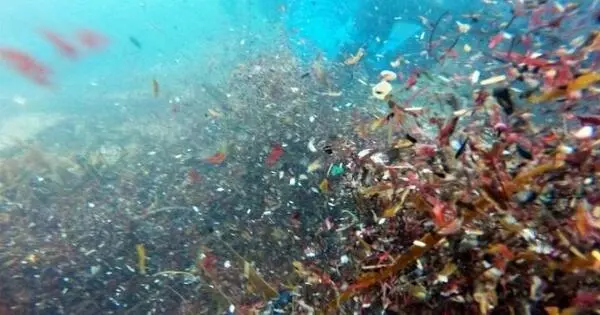It is well known that microplastics, which are small plastic particles that are less than 5mm in size, are a major environmental pollutant. They can be found in oceans, lakes, and rivers, and are harmful to marine life and ecosystems.
According to recent research, the amount of microplastics deposited on the seafloor has been increasing at an alarming rate. In fact, some studies have found that the amount of microplastics on the seafloor has tripled in the last 20 years. This is a serious concern, as the accumulation of microplastics on the seafloor can have negative impacts on the health of marine ecosystems and the animals that depend on them.
The total amount of microplastics deposited on the ocean floor has tripled in the last two decades, a trend that corresponds to the type and volume of plastic products consumed by society. This is the main finding of a study conducted by the Universitat Autnoma de Barcelona’s Institute of Environmental Science and Technology (ICTA-UAB) and Aalborg University’s Department of the Built Environment (AAU-BUILD), which provides the first high-resolution reconstruction of microplastic pollution from sediments collected in the northwestern Mediterranean Sea.
Despite the seafloor being considered the final sink for microplastics floating on the sea surface, the historical evolution of this pollution source in the sediment compartment, and particularly the sequestration and burial rate of smaller microplastics on the ocean floor, is unknown.
We were able to see how, since the 1980s, but especially in the last two decades, the accumulation of polyethylene and polypropylene particles from packaging, bottles, and food films, as well as polyester from synthetic fibers in clothing fabrics, has increased.
Michael Grelaud
This new study, published in the journal Environmental Science and Technology (ES&T), shows that microplastics are retained unaltered in marine sediments, and that the microplastic mass sequestered in the seafloor mimics the global plastic production from 1965 to 2016. “Specifically, the results show that, since 2000, the amount of plastic particles deposited on the seafloor has tripled and that, far from decreasing, the accumulation has not stopped growing mimicking the production and global use of these materials,” explains ICTA-UAB researcher Laura Simon-Sánchez.
The sediments studied have remained undisturbed on the seafloor for decades, according to the researchers. “We were able to see how, since the 1980s, but especially in the last two decades, the accumulation of polyethylene and polypropylene particles from packaging, bottles, and food films, as well as polyester from synthetic fibers in clothing fabrics, has increased,” explains Michael Grelaud, ICTA-UAB researcher.
Polypropylene is the most abundant of these three types of particles, accounting for 1.5mg per kilogram of sediment collected, followed by polyethylene and polyester. Despite public awareness campaigns emphasizing the importance of reducing single-use plastic, data from annual marine sediment records show that we are still a long way from meeting this goal. Policies at the global level in this regard could contribute to improving this serious problem.

Although smaller microplastics are very abundant in the environment, constraints in analytical methods have limited robust evidence on the levels of small microplastics in previous studies targeting marine sediment. In this study they were characterised by applying state-of-the-art imaging to quantify particles down to 11 µm in size.
The degradation status of the buried particles was investigated, and it was discovered that once trapped on the seafloor, they no longer degrade due to a lack of erosion, oxygen, or light. “Fragmentation occurs primarily in beach sediments, on the sea surface, and in the water column. Because degradation is minimal once deposited, plastics from the 1960s remain on the seafloor, leaving a trace of human pollution “Patrizia Ziveri, ICREA professor at ICTA-UAB, agrees.
The investigated sediment core was collected in November 2019, on board the oceanographic vessel Sarmiento de Gamboa, in an expedition that went from Barcelona to the coast of the Ebro Delta, in Tarragona, Spain. The research group selected the western Mediterranean Sea as a study area, in particular the Ebro Delta, because rivers are recognized as hotspots for several pollutants, including microplastics. In addition, the influx of sediment from the Ebro River provides higher sedimentation rates than in the open ocean.
The main sources of microplastics in the oceans are believed to be the breakdown of larger plastic items, such as plastic bags and bottles, and the release of microfibers from synthetic clothing during washing. In addition, microplastics can also come from the use of personal care products that contain microbeads, which are small plastic particles used as exfoliants.
To address the problem of microplastics in the oceans, it is important to reduce our use of single-use plastic items and to properly dispose of plastic waste. In addition, the use of microbeads in personal care products has been banned in some countries, and there is ongoing research into ways to remove microplastics from the oceans.
















